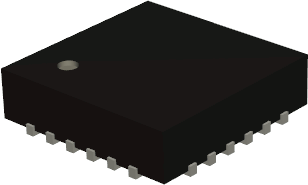QFN chips
07 September 2019This was originally part of a currently unpublished article on the try-out of the NXP
LPC11Uxx but I felt that it was better to spin the content out into its own article, as it covers issues that affected multiple circuits I was working on at the same time. QFN (Quad Flat No-leads) are small square chips that have just pads in grooves rather than leads, and are the smallest-scale chip I have used.

Since there is usualy an exposed pad on the under-side that needs to be soldered to ground — and it typically is the only ground pad so it cannot be left dry — QFN chips basically have to be reflow-soldered rather than hand soldered, at least given the equipment I currently have. These days I think putting down solder paste with a stencil and then placing the components is messy, especially with the small landings a lot of chips have, and in any case you likley as not have to do some rework by hand anyway. One of the specific problems with QFN chips is that you cannot really tell whether any bridges formed under the chip, so you are hoping any excess has flowed out and bridged on the outside instead.
On the plus side QFN chips have no leads to mess up and on the whole seem a lot more robust — the first time a reflowed a pair of boards with them one detached when the PCB was dropped before the solder had solidified, but I was able to reheat the board and in the end it worked perfectly. I am wondering whether I should invest in a hot air station, as that is the only way I can think of hand soldering QFNs rather than reflowing.